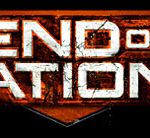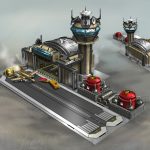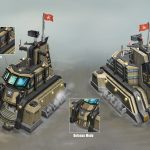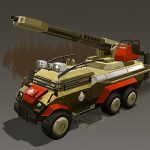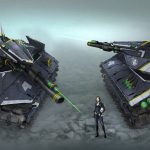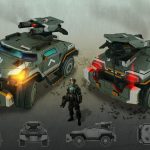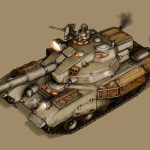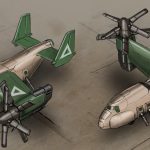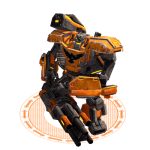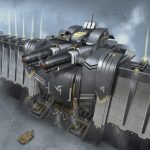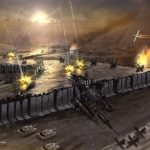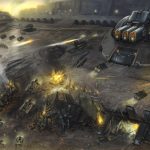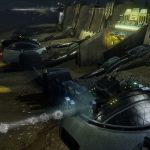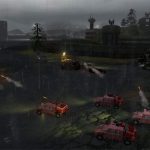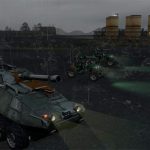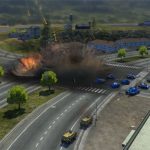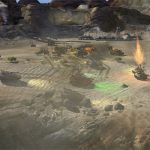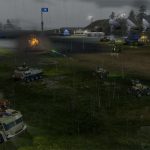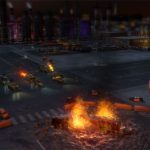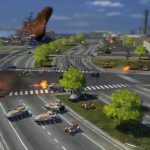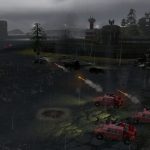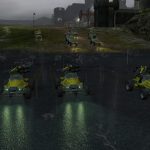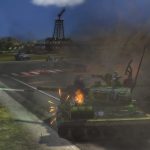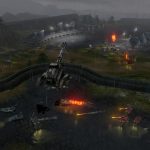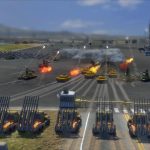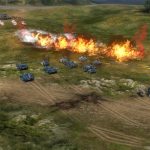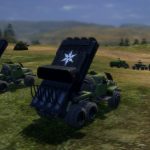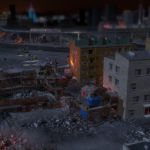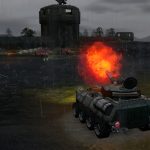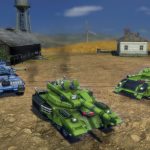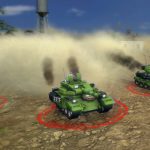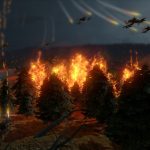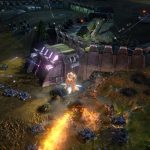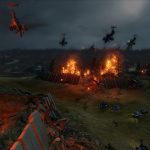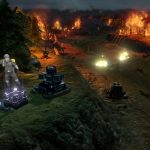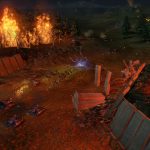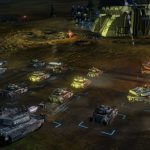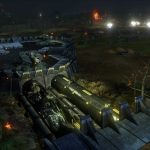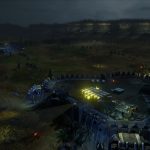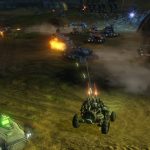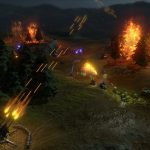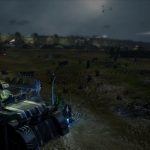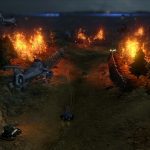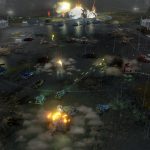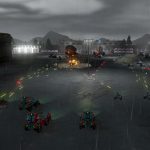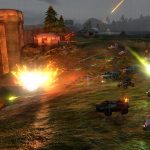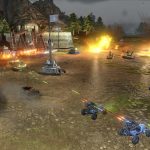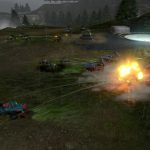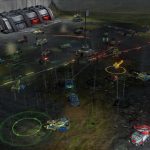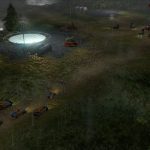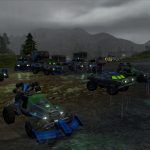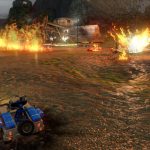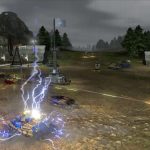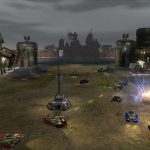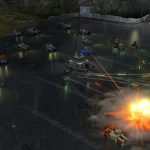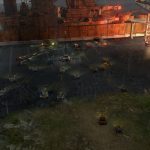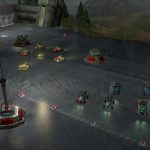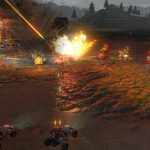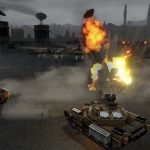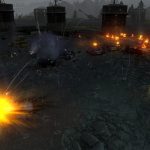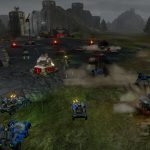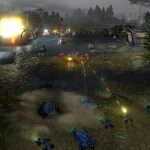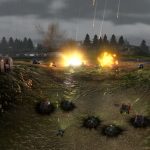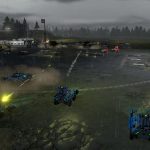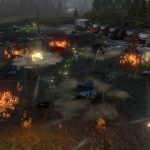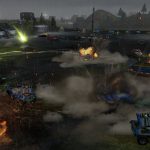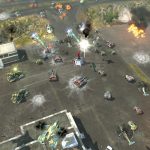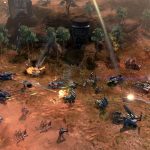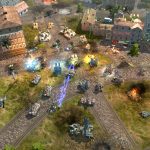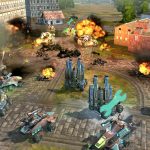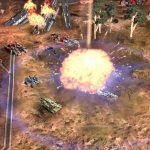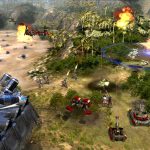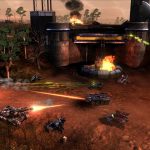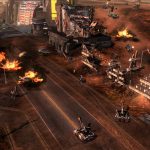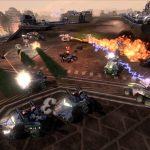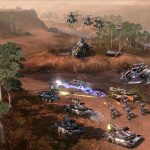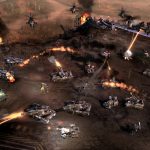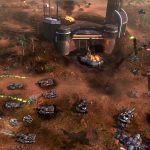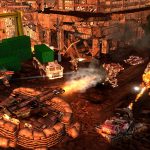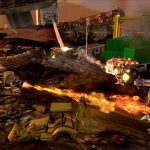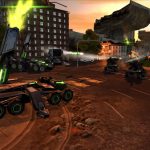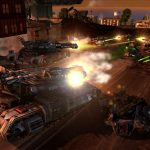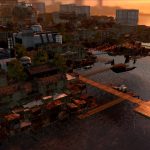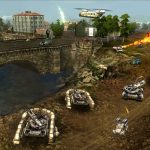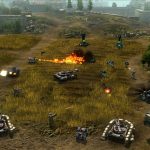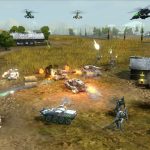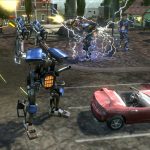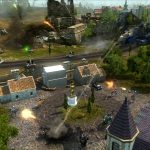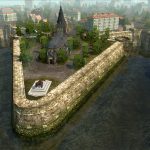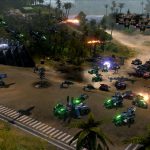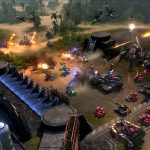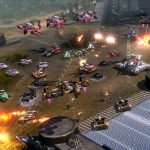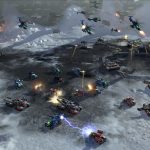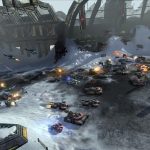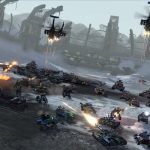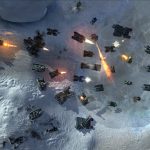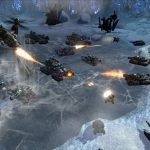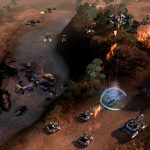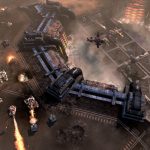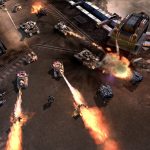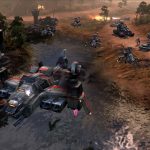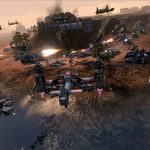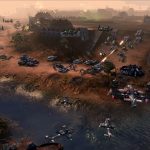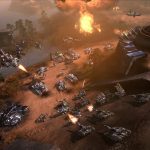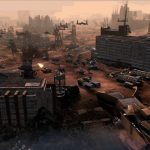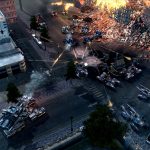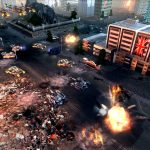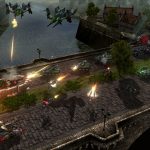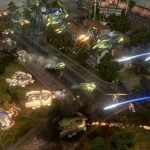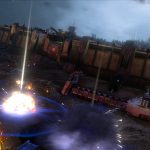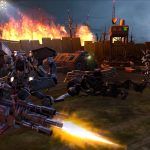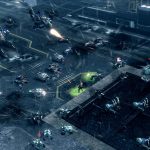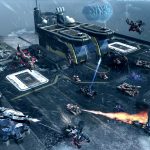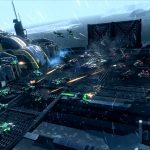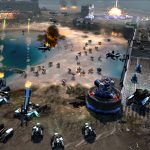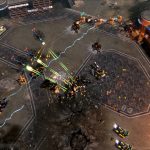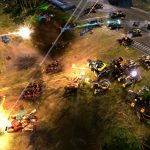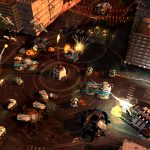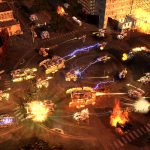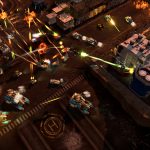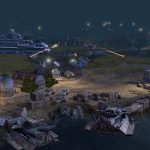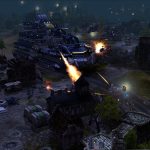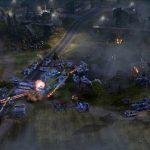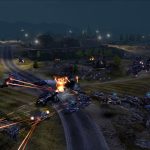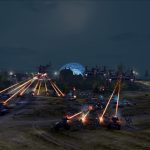End of Nations is a canceled Free-To-Play Massively Multiplayer Online Real-Time Strategy game, which was later a Multiplayer Online Battle Arena game, published by Trion Worlds and developed by Petroglyph Games from 2009 to 2013, exclusively for PC.
This project between Petroglyph and Trion Worlds was first mentionned in April 2009 by its publisher, as we can read on Gamespot:
(…) Trion World Network has announced that it has partnered with Petroglyph on an as-yet-to-be-named massively multiplayer online real-time strategy game.
Aside from talking up the Petroglyph team’s previous work on such titles as Command & Conquer and Dune II, Trion revealed no relevant gameplay details about the upcoming project. However, Petroglyph appears to be taking an ambitious approach to the project, with Trion CEO Lars Buttler saying of the game that it will be “the world’s first truly high-end MMORTS.”
The game was officially revealed in April 2010:
Trion’s MMORTS collaboration with Petroglyph is also expected to arrive for the PC next year. Titled End of Nations, the RTS features a persistent online world in which gamers can engage in solo or multiplayer combat with “thousands of other gamers across the gigantic battlefields.”
Details on Petroglyph’s latest effort remain light. However, Trion did note that players will be able to develop their own commanders and establish a headquarters. Gamers will also be able to unlock new vehicles, weapons, and technologies through combat, as well as crafting and researching.
Further details about its background emerged later:
We are introduced to the universe of End of Nations with a synopsis of the events leading up to the present conflict. 50 years into the future, a worldwide economic crisis and collapse has resulted in a cascade of shortages and conflicts. This coincided with the failure and dissolution of almost all of the world’s governments. As the world descended into anarchy, a savior emerged. The United Nations stepped in to restore order through aid and military force. The public reaction to this was initially enthusiastic. As the governments of the world had failed, the United Nations, now renamed the Order of Nations (ON), became the sole government of the world. To the shock and horror of the populace, this new government began to abduct people in the middle of the night and execute its citizens for asking questions. As a result of this oppression, resistance movements emerged.
When the game begins, the resistance has been underway for quite some time. The Liberation Front, led by American war hero General Alec Chase, and the Shadow Revolution, led by former Order of Nations assassin Monkh Erdene, are part of the Coalition, an alliance against the Order of Nations. The commander controls part of the Coalition forces sent to assault the Typhoon Cannon, a massive artillery turret, at the Order of Nations base at Widow’s Wall. The leader of the Order of Nations, General Sevastian Korvus, is also present, residing within the Typhoon Cannon. The assault on the Typhoon Cannon is successful. The cannon is destroyed and Korvus is killed. Yet, the allies bicker. With the destruction and collapse of the Typhoon Cannon, there is now a giant breach in Widow’s Wall. Alec Chase of the Liberation front wishes to advance further into the base, but Monhk Erdene of the Shadow Revolution counters that their coalition has captured the Siege Cortex and that further advance into the base is not part of the mission. Land battleships from the Order of Nations, known as Assault Panzers, approach from both sides of the breach outside the wall. General Chase asks Monkh to engage the enemy forces so that he can assault the inner base. Monkh apologizes to Chase, reiterates that it was not part of the mission, and the Shadow Revolution forces withdraw. Outflanked and without sufficient support, General Chase is forced to withdraw as well, sustaining casualties in the process. Allies no more, the Liberation Front and Shadow Revolution continue to fight the Order of Nations while also fighting and sabotaging each other for control of territories and influence over populaces. And thus the stage was set for further conflicts between the three factions.
Factions
There are three factions in End of Nations. Two of those are playable; the Liberation Front and the Shadow Revolution. The third faction is the unplayable computer controlled Order of Nations, the main antagonist of the game.
Liberation Front – Increasing chaos led the world leaders to give up control to the Order. The Lord Chancellor of England, Mary Dickinson, refused to give up control of her people. She decided to fight against this regime, and began distributing a digital pamphlet codenamed “The Sentinel”. She began to coordinate these dissidents. The Liberation Front believes that people should be free to elect their leaders and form their own governments. They will go to the grave to fight for this right. The Liberation Front has two classes: Spartan and Patriot, each with their own advantages and special abilities. The Spartan is all about heavy armor and point defense. The Patriot class is more of a support class, and with their support powers, they are able to greatly influence the battlefield.
Shadow Revolution – A few people believe that the new regime’s oppression of the people was far too violent. These dissidents were killed, including Donald Poole who oversaw the rule of Eastern Europe. His son, Robert Poole, and Sabal Dasgupta came together and secretly formed an army of their own known as the Shadow Revolution. As former members of the Order of Nations, they arm themselves with weapons and technology stolen from their former organization, along with knowledge of the inner workings of the Order. They are trying to realize Pierre Frenay’s vision of a firm but benevolent rule. The Shadow Revolution has two classes, the Wraith and Phantom classes, each having their own advantages, and special abilities. The Wraith class is all about fast hit-and-run tactics. The Phantom class is all about stealth tactics and ambushes.
Order of Nations – Perverted from one man’s dream of a peaceful world government, the Order of Nations rules the globe with violence, oppressing the masses and crushing any in their path. The Order possesses extremely advanced weapons systems, developed using siphoned off money and resources, in hopes of creating an army dedicated to establish a one world order. This army was advanced and powerful enough to overwhelm the militaries of the world’s nations and take control with ease. Order of Nations is the AI controlled, third faction in End of Nations. Order of Nations units can be seen in most PvE and some PvP maps. Order of Nations units and buildings have darker color scheme than Liberation Front or Shadow Revolution.
During its development at Petroglyph, the title was showed numerous times at the press, during E3 2010, Gamescom 2010 and E3 2011, and Gamespot was able to write several previews for the game:
You will play as a one of three professions–tank commander, strike commander, or artillery commander. Tank commanders specialize in tanks, the meat-and-potatoes combat unit of the game that balances good armor with good firepower; strike commanders specialize in smaller, faster tactical vehicles; and artillery commanders specialize in less-armored but devastatingly damaging long-range artillery. While these professions grant you specialized abilities and bonuses that are weighted toward one of the game’s three vehicle classes, there’s nothing stopping tank commanders from adding a couple of light vehicles or mortars to their armies if they need slightly more well-rounded troops in the next mission. All missions are at the war room interface, which lets you find hot spots around the globe (including key areas where your faction is losing ground and needs support) and check in on your holdings and your standing armies.
Your avatar in the game is a persistent headquarters that does not exist in the open world but in its own private instance. You can build up your HQ, much like you would upgrade your base in a conventional real-time strategy game, with such upgrades as an airfield, which will then unlock the ability to call in a devastating air strike. The war room also lets you jump to your character’s armory, which houses all your units. Over time, you’ll collect various tanks, artillery cannon, and light vehicles in a giant virtual garage.
The mission we watched was a midlevel PVE instance in which the Order of Nations controlled a ruined industrial area with small companies of tanks and light vehicles, as well as a gigantic boss. The huge map, a virtual 20-square-mile expanse of derelict factories and shattered concrete, was populated by several small pockets of enemy vehicles that our expeditionary force was able to defeat fairly easily. However, once we got to the boss, a gigantic, landed battleship with tank treads dumped caches of missiles and electromagnetic pulse payloads on our heads. Fortunately, by this point in the demonstration, we had been joined by several other players who joined an impromptu group. High-level bosses like these will definitely require coordinated teams of players to take down, all firing off their special abilities and using support powers, such as “healing,” which won’t be exclusive to any one profession.
End of Nations seems like an interesting take on online strategy. The game seems to be taking the approach of drawing direct analogues between massively multiplayer archetypes and real-time strategy archetypes. Your HQ and units are like persistent characters who grow stronger over time with upgrades; missions act like instances; there will be plenty of story-driven PVE content for players who don’t necessarily want to play PVP at that moment; and instances will be presided over by huge, raid-style bosses. This unique game is scheduled to launch next year.
At Gamescom 2010, it was its multiplayer component that got a preview:
End of Nations’ multiplayer matches will resemble the conquest mode of games like the Battlefield series in that they will feature various key points that can be captured for your side by sending your army into the vicinity of each hotspot and hanging out until a meter ticks down and the point flips over to your team’s control. All maps contain victory points that, when captured, earn your team points that count toward an eventual victory, but several maps will also have separate points of interest that, when captured, will provide extra bonuses in battle, such as airfields that provide extra uses of the air strike ability.
Our own multiplayer session started on a large, symmetrical temperate map with 10 players, five on each side. We ended up playing a light assault squad that was more focused on speed than on firepower on the blue team with a fistful of light fast-attack vehicles and an unarmed tactical vehicle for using various special abilities. The map itself had several victory points to capture, but the primary victory point lay at the dead center, and presumably to give us a good demonstration of combat, the Trion team primarily clustered around this center point. We decided to try to take advantage of our hosts’ hospitality and hide out from the initial skirmish, which our opponents won, later sneaking in to capture the control point.
We would have gotten away with it too, if it weren’t for that pesky entire red team, which chewed up the majority of our forces with withering tank fire, leaving only our slow-moving, unarmed support vehicle to desperately try to get to cover, though at one point, the majority of the enemy team withdrew to guard the hotspot, leaving only one enemy squad to mop us up, at which point, we called in a carpet-bombing air strike, painting the very tracks of our last vehicle. This last-ditch trick actually paid off and the air strike completely destroyed our weakened pursuer. Unfortunately, there wasn’t much else we could do with an unarmed vehicle, so we chose to voluntarily kill off our own squad and respawn, and this time, to not be such a jackass. We fell in line behind our teammates, some of whom had heavier tanks that were better at soaking up damage, while we laid down covering fire and generally tried not to die, which worked out a lot better for us.
However, after it went into closed beta in October 2012, Petroglyph suffered in December of the same year several layoffs after the game was postponed, as we can, again, read on Gamespot:
As many as 30 developers at End of Nations studio Petroglyph Games have been laid off, Eurogamer reports. Though not confirmed from the Las Vegas, Nevada studio itself, tweets from game designer Adam Stevens seem to confirm the news.
“Well, it appears this winter break will be extended indefinitely,” Stevens said. This was followed by, “Layoffs at Petroglyph. Looking like I’ll be leaving Las Vegas.”
News of layoffs at the company follows publisher Trion and Petroglyph indefinitely postponing the open beta phase for End of Nations, with refunds going out to those who had already made a purchase. Petroglyph said “several key areas” of End of Nations need “polish and improvement.”
Two days later, Eurogamer stated that it was been taken over internally by Trion Worlds:
Persistent online RTS End of Nations hasn’t been scrapped or shelved, despite foreboding news of lay-offs at developer Petroglyph.
That’s because End of Nations development has moved from Petroglyph internally to publisher – and maker of Rift – Trion.
Community manager Myll Erik explained:
“Hey guys, I wanted to give you a status update on End of Nations and let you know that we’re still moving full steam ahead with the game,” he wrote in the game’s forum.
“In light of the recent announcement around postponement of the End of Nations open beta, we wanted to let you know what we have been hard at work getting End of Nations to the quality level it needs to be at. We are committed to delivering the top-notch product we know this game can be, and we are looking forward to welcoming you back into the testing phase of the game to help get it there. ”
Some of the things the team is working on is easing the level curve for new players, revamping the UI, increasing player strategy and generally polishing the experience.
“As End of Nations was reaching the pre-launch phase in its lifecycle, we officially brought the game development in house to Trion Worlds and will complete the development internally,” Erik added.
“Our team has been hard at work implementing many changes based on your feedback from the beta events. Keep checking back for more updates as we are looking forward to showing off some of the cool new things the team has been working on.”
The project resurfaced in July 2013, thanks, again, to Eurogamer, as a MOBA:
Troubled RTS MMO End of Nations has reappeared as “the first MOBA RTS”, according to its website.
“End of Nations is a tactical MOBA where your success on the battlefield depends on the heroes and units you command and quick decision making in the heat of combat,” it reads. “Dominate during team-based matches and catapult your commander to the top of the ranks.”
End of Nations dropped out of sight last December, when development was taken from creator Petroglyph and moved in-house to Trion. Evidently the beta-stage MMO RTS went under fierce review and the suits decided it didn’t have much of a shot at success.
Unfortunately, it seems that this attempt didn’t work as planned, as the game was definitely cancelled some months later, late 2013:
Sci-fi MOBA End of Nations appears to have been cancelled after the game’s website was taken offline and all reference to the game removed from publisher Trion’s website.
Responding to questions about the game’s status from VideoGamer.com earlier today, Trion Worlds said:
“As we informed EON’s community last fall, internal development on End of Nations was put on hold in late 2013 while we evaluated potential paths forward for the title. We’re currently focusing the company’s energy and creativity on Rift, Defiance, Trove, ArcheAge, and some new projects that we will be revealing soon.”
While Petroglyph Games is still around to this day, Trion Worlds was disbanded in October 2018, after being purchased the same month by Gamigo.
Videos:
Images:
What do you think about this unseen game? Give your vote!
Would you like to add more info, screens or videos to this page? Add a comment below!
- F.E.A.R. 2 (Day 1 Studios) [PC / PS3 / Xbox 360 – Cancelled Pitch] - 25-01-2025
- Project 1V1 [PC – Cancelled] - 21-12-2024
- Enemy Front [PC / Playstation 3 / Xbox 360 – Cancelled] - 21-09-2024


